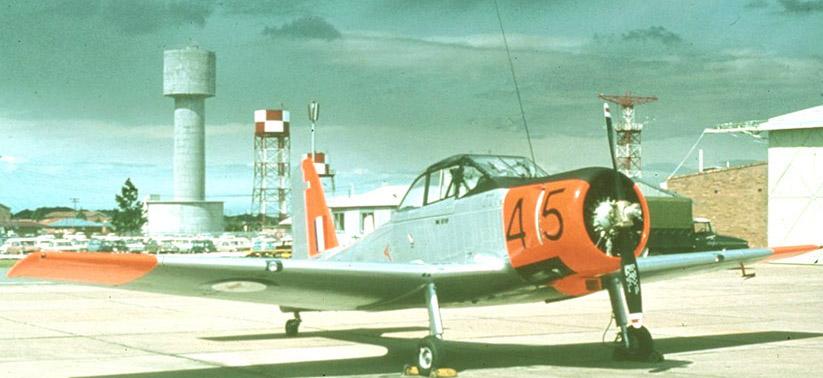
A85-445 conducted ARDU trials in 1969 for the re-roling to a training FAC capability. (via John Bennett).
by Ryan Hamilton

A85-445 conducted ARDU trials in 1969 for the re-roling to a training FAC capability. (via John Bennett).
Airframe History
The CAC Winjeel, an Australian-designed and built military trainer aircraft, holds a significant place in the history of the Royal Australian Air Force (RAAF). Developed by the Commonwealth Aircraft Corporation (CAC), the Winjeel first took to the skies in 1951, with its introduction into service occurring in 1955. The aircraft was designed to replace the de Havilland Tiger Moth and CAC Wirraway, offering more modern training capabilities for pilots. Characterized by its low-wing monoplane design, the Winjeel was equipped with the traditional Pratt & Whitney R-985 Wasp Junior radial piston engine. Its name, derived from an Aboriginal word meaning "young eagle," aptly reflected its role in shaping novice aviators into proficient pilots.
The Winjeel served the RAAF for several decades, primarily as a basic trainer until it was gradually phased out in favor of the PAC CT/4 Airtrainer and CAC Macchi in the late 1960s, early 1970s. Despite its retirement from active military service, the Winjeel remains a beloved aircraft among aviation enthusiasts and historians. Many examples are preserved and maintained by private collectors and aviation museums, continuing to grace airshows and events across Australia. The aircraft's enduring legacy is a testament to its pivotal role in Australian aviation history, symbolizing the transition from World War II-era training methods to more contemporary practices that laid the foundation for future generations of RAAF pilots.
In the Forward Air Control (FAC) role, the CAC Winjeel showcased its versatility beyond its primary function as a training aircraft. During the Vietnam War, the need for effective aerial reconnaissance and coordination led to the adaptation of several Winjeels for FAC duties. These modified Winjeels were tasked with directing airstrikes and artillery fire, a critical role that required precise navigation and communication skills. The aircraft's robust construction and reliable performance made it suitable for the low-altitude, slow-speed operations typical of FAC missions. Equipped with smoke rockets and flares for marking targets, the Winjeels provided invaluable support to ground forces, enhancing the accuracy and effectiveness of military operations.
The Winjeel's tenure as a FAC aircraft demonstrated its adaptability and the ingenuity of the RAAF in repurposing available resources to meet operational demands. Pilots operating in the FAC role relied on the Winjeel's stable handling characteristics and good visibility to perform their missions effectively. Despite its relatively short stint in this capacity, the aircraft left a lasting impression on those who flew it and benefited from its capabilities. The experience gained from using the Winjeel in FAC operations contributed to the development of more advanced FAC aircraft and techniques, underscoring the importance of versatile platforms in modern warfare. The Winjeel's contribution to FAC missions remains a notable chapter in its diverse service history.
FAC History
On the 1st of April 1970 No 4 Forward Air Control Flight was formed as an independent unit at RAAF Base Williamtown, New South Wales, to train RAAF, RAN and Army pilots in all facets of Forward Air Control (FAC) work. Initially, four Winjeels, A85-412, A85-413, A85-436 and A85-445 were brought up from 1FTS at Point Cook to test FAC duties with the Winjeel from late 1969. These airframes were standard trainer Winjeel's, without adequate radios for air to ground communication or the ability to drop smoke markers. Overall, sixteen airframes would be utilised in the FAC role, with four airframes on active service in the squadron and the remaining twelve airframes in storage at RAAF Wagga Wagga.
No.4 Flight quickly fitted the Winjeels with additional radios compatible with Army tactical networks, smoke grenade dispensers for target marking, and an establishment of just two personnel. With the additional radio's required for FAC operations, these were installed in the rear cockpit where the third seat would normally occupy. The first sortie in conjunction with the Army at Singleton, NSW, was on 6 April, 1970 using aircraft A85-413.
Although No.4 Flight was an independent unit, much of the administration for the unit usually transited through No 2 Operational Conversion Unit (2 OCU). In 1985-86 with the introduction of the F/A-18 Hornet to the RAAF, the administration for No.4 Flight was moved over to 77 Squadron. Shortly after this move, 2 OCU found that the complexities of introducing the F/A-18 were such that the decision was made to move the CAC Macchi's to another squadron to allow 2 OCU to concentrate on Hornet operations and conversions solely. On the 1st January 1989, 76 Squadron was reactivated with A and B flights consisting of CAC Macchi's and C flight with CAC Winjeels. Winjeels would remain with 76 Sqn till June 1994 when the type was finally retired. Although it had been planned to retire the type from 1968, it was still considered suitable for FAC work until replaced by the Pilatus PC-9.
Airframes
Since 1969, the following airframes have been used as FAC Winjeels. A85-407, A85-409, A85-410, A85-411, A85-412, A85-413, A85-414, A85-415, A85-426, A85-435, A85-436, A85-438, A85-442, A85-443, A85-445 and A85-458.
Losses
Since 1969, four FAC Winjeels have been lost due to accidents -
A85-409 - Delivered to the RAAF in 12/55. Used by 76 Sqn as FAC Aircraft. Crashed 28/03/88. Landing accident (believed to have been a side slipped and resulting stall on approach), RAAF Williamtown. Crew SQNLDR Paul Carter and LAC Anthony McNeill killed.
A85-412 - Delivered to the RAAF in 02/56. Used by 2 OCU/76Sqn as FAC aircraft from 1970. Crashed 10/69, Shoalwater Bay QLD.
A85-414 - Delivered to the RAAF in 02/56. Used by 2 OCU/76 Sqn as FAC Aircraft from 1968. Crashed 04/69, Bulehdelah NSW.
A85-458 - Delivered to the RAAF in 10/57. Used by 76 Sqn and 77 Sqn as FAC Aircraft. Crashed 24/02/88, Wauchope NSW. Both Flying Officer M. Greentree and Leading Aircraftman I. Ross killed.
Click on the 'Next' button to go to Page 2 of the article